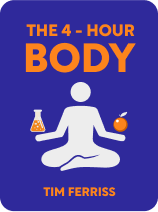

This article is an excerpt from the Shortform book guide to "The 4-Hour Body" by Timothy Ferriss. Shortform has the world's best summaries and analyses of books you should be reading.
Like this article? Sign up for a free trial here .
What is the minimum effective dose in The 4-Hour Body? How does MED for weight loss work?
The minimum effective dose is a concept shared in The 4-Hour Body. The idea is to do the least amount needed to get the result you desire. It is more efficient and less likely to result in injury.
Keep reading to understand minimum effective dose, including MED for weight loss.
Minimum Effective Dose
An important part of your experimentation will be to find the minimum effective dose (MED), which is the smallest dose that will create a particular result. For example, the MED to boil water is 212 degrees Fahrenheit. Heating water past 212 degrees doesn’t make it any more boiled. Further heating just wastes fuel.
Whenever you want to make a change to your body, only do the minimum that’s required to cause the change. The minimum effective dose is desirable for two reasons:
Reason #1: Avoiding injury. If you do more than you need to, you’ll actually slow your progress or go backwards because you’ll tire yourself out and overload your body’s healing mechanisms.
- For example, if you need to put your shoulders under 100 pounds of tension for two minutes twice a week to strengthen them, don’t train every day—you’ll put your shoulders under unnecessary strain and risk injury. Instead, only do the minimum.
Reason #2: Saving time and energy. Pareto’s principle states that in general, 80% of results are caused by 20% of the effort. When it comes to performance science, the ratio is even higher—according to the author, 2.5% of effort is responsible for 95% of results. Doing more than you have to isn’t going to have much effect and is a waste of your time.
Getting Tested
There are limits to what you can learn from self-experimentation if your only data-gathering technique is observation. For example, you might notice that after eating bananas, you feel better, but this could be for a variety of reasons—bananas contain important nutrients, so perhaps you were feeling unwell because you were deficient in those nutrients. Or, you could have just been hungry. Either way, you might have felt even better if you ate something else. To learn more about what’s actually going on with your body, you need to have tests done. This will help you determine your minimum effective dose, especially an MED for weight loss.
There are three rules for testing for minimum effective dose:
- Don’t test anything you can’t change. There’s no point in knowing you’re predisposed to an illness if you can’t do anything about it.
- Double-check alarming results. If you get a result that requires you to make a big change, get retested, ideally by a different lab, to confirm the result.
- When retesting, try to create the same conditions as the original test. Take your tests on the same day of the week, around the same time, and at the same time in your menstrual cycle (if applicable).
We’ll look at specific tests for specific goals beyond minimum effective dose in later chapters, but the author encourages you to get tested every six months (every three if you’re not eating animal products) to make sure your body is working properly. Everyone should test their aspartate aminotransferase and aspartate aminotransferase (for liver health), total cholesterol (for, among other things, heart health), and follicle-stimulating hormone, luteinizing hormone, estradiol, and prolactin (for sexual health). Men should additionally test their testosterone levels and get their semen analyzed. Women should additionally test their egg supply.
Your insurance might cover your testing, but US doctors often won’t order preventative tests, especially images, because this can open them up to audits by insurance companies. Even if you have to pay for your tests yourself, they’re worth it—they help you detect health problems early and determine your minimum effective dose.
Medical Tourism
Often, testing is less expensive in other countries than the US, so consider getting your tests done while you’re traveling, or plan a trip around them. For example, when the author went to Nicaragua on a surf and writing trip, he also had some MRIs and urine and blood testing done. He paid $400 per MRI (they’re $750 in the US) and he saved $640 on urine and blood tests. Altogether, he saved $3,090, which was more than the cost of his trip.

———End of Preview———
Like what you just read? Read the rest of the world's best book summary and analysis of Timothy Ferriss's "The 4-Hour Body" at Shortform .
Here's what you'll find in our full The 4-Hour Body summary :
- How to do the least amount you need to do for the results you want
- Why you need a cheat day in your diet
- How to improve everything about your body, including sleep, sex, and longevity






